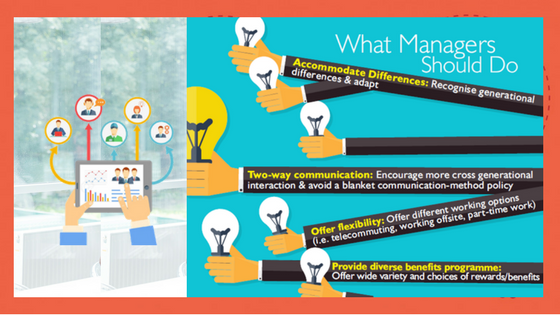
Generational diversity at the workplace is both a challenge and an opportunity for companies. Each generation brings its unique set of skills, values, priorities, attitudes, experiences, and approach to work-life balance, style of working and ways of communication, amongst others. If handled appropriately, it can foster greater interaction, thus leading to increased creativity, innovation, cross pollination of ideas, and thus better collaboration and synergies, thereby giving the organisation a competitive edge. To engage this multi-generational workforce and retain the best talent, organisations need to adapt their talent management strategies to respond to their peoples' changing needs.
Strength lies in differences, not in similarities
- Stephen R. Covey
Bridging the generational gap
The “one size fits all” approach will not work, as different generations respond differently to situations and strategies. Moreover, the complexities of communication have become far more pronounced in the workplace of today. Communication being a key driver of employee engagement, companies should adopt the appropriate vehicle(s) of communication which would appeal to all generations.
Several barriers stand in the way of knowledge transfer within a multigenerational workforce. To tackle this, it is critical that HR managers pay special attention to understand the differences in learning styles between generations and devise appropriate learning & development programmes. Generational differences can also be bridged through constant interaction by increasing collaborations and strengthening the bonding between employees across generations.
Mentoring: A tool to improve cross-generational employee engagement
Mentorship can open effective channels of communication between generations. Companies are facilitating interaction/mentoring between employees across different generations wherein the younger employees benefit from the wisdom of the tenured employees, while the older generation understands fresh perspectives from their counterparts. Reverse mentoring, wherein the older generations learn from their younger counterparts, is also a successful strategy adopted by companies in bridging generational gaps, breaking down barriers and improving engagement levels.
Designing an inclusive rewards & recognition strategy
Rewards & recognition programs are a powerful tool to engage the workforce and achieve business objectives. The R&R programme of an organisation should be responsive to the changing organizational dynamics and workforce composition. The different aspirations, references, work styles and goals of a multi-generational workforce make it even more important for the people managers to design a rewards strategy which appeals to all the generations. By capitalizing on the strengths and values of a multi-generational workforce, recognition programs can realise the true potential of an organisation's talent base and create an enduring competitive edge.
Best Practices in R&R Programs for Multiple Generations
Source: www.sodexomotivation.com
End note
Multi-generational diversity is here to stay. Organisations should leverage a generationally diverse workforce to their competitive advantage. This is because it is this mix of various generations that would bring in the relevant experience and the right attitude to drive businesses of tomorrow. Businesses which nurture this unique workforce blend and exploit it as a competitive tool will be in a winwin situation. Hence, it is prudent for managers to deploy relevant engagement tools and practices and use generational diversity as a valuable strength to create a more attractive, cohesive and productive workplace.
Publsihed with permission from Engage Sodexo Newsletter, Issue 3.